If you have a website, you are probably thinking about attracting users and converting them into leads. This is where a lead generation campaign can help.
Today's lead generation is an automated process and the key component of personalized communication with customers.
In this article, you will learn:
- what lead generation campaign is, and why do you need it;
- what lead management is and how to build it;
- how to collect leads and find targeted ones;
- how different businesses set up lead generation.

What is Lead Generation Marketing in simple words
What is a lead?
A lead is a person who has expressed a desire to purchase from you or just showed interest in your product. This can be defined in the following actions:
1) The person subscribed to your email list;
2) The person left their contact details in any form of lead generation on the website (application form, callback, consultant, etc.);
3) The person called you on the specified phone number.
The word "lead", capacious and strong, has replaced the similar expression "potential customer".
In general, a person becomes a lead after they have left their contact information or made contact. To do so, of course, they first saw your ad or somehow found out about you.
Usually, such potential customers can learn about your brand through lead generation. And it works. This person is interested in the offer and desires to make a purchase.
Not every lead becomes a buyer. The purchase is the next stage of the sales funnel. At the purchase stage, the lead is processed by other tools.
So, the one who bought is the customer. The one who saw our ad is not a lead. The one who called to check prices and ordered a callback or free consultation is a lead.
What is Marketing Qualified Lead (MQL)?
A marketing qualified lead (MQL) is a potential customer who has demonstrated a certain level of interest in your product or service based on their participation in your marketing efforts. Typically, MQLs are defined using scoring and grading techniques that assess their behavior and demographics.
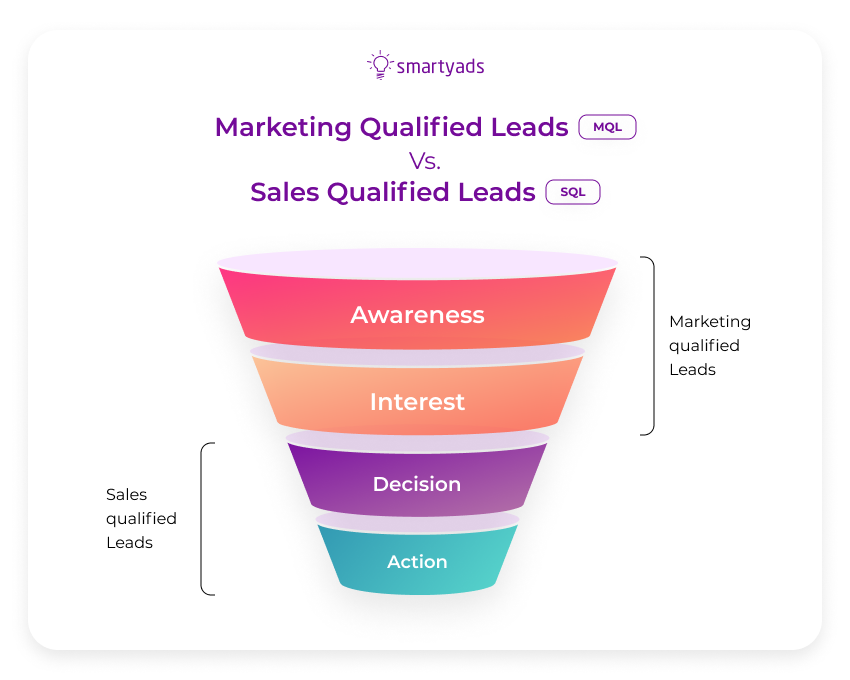
MQLs are frequently in the early stages of the buyer's journey and not yet ready to purchase, but they have shown interest in your product or service and are a good fit for your target audience.
Examples of MQLs are site visitors who have downloaded a white paper, attended a webinar, or participated in your social media channels.
Marketing teams use MQLs to identify leads that require further development and training before they are ready for transfer to the sales team.
By focusing on MQLs, marketing teams can optimize their lead generation activities, improve the quality of leads, and ultimately increase company revenue.
Once MQLs are identified, marketing teams typically use targeted email campaigns, content marketing, and other customer nurturing tactics to educate and interact with customers, moving them further down the buyer's journey until they become qualified sales leads (SQLs) and are ready to be handed off to the sales department for further follow-up.
What is Sales Qualified Lead (SQL)?
A Sales Qualified Lead (SQL) is a prospective customer with a higher likelihood of becoming a paying customer than other leads in your sales pipeline.
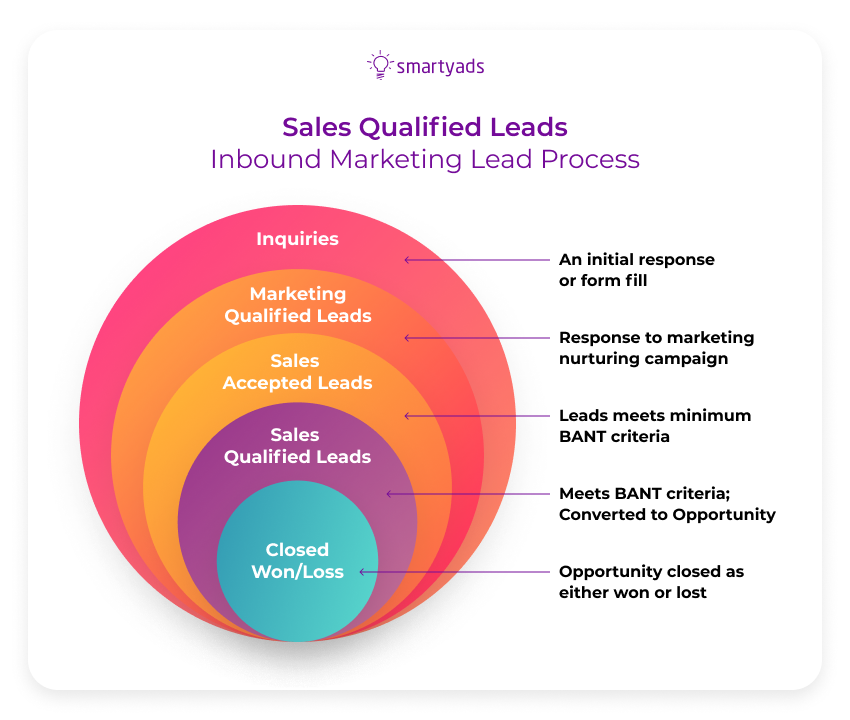
The sales department typically identifies SQLs after they have been qualified through a series of lead nurturing activities, such as engaging with your website, filling out a lead capture form, or responding to targeted marketing campaigns.
Get your sales team involved
SQLs are further along in the customer's journey, have demonstrated a clear interest in your product or service, and have the budget, authority, and need to purchase. The sales team will prioritize these leads and move them further through the sales pipeline, ultimately closing the deal.
To identify SQLs, teams typically use a combination of lead scoring and lead grading methods to evaluate the quality of each lead based on factors such as demographic information, behavioral activity, and firmographic data.
By focusing on SQLs, sales teams can optimize their time and resources, increase their conversion rates, and ultimately generate more revenue for the business.
What is Product Qualified Lead (PQL)?
A Product Qualified Lead (PQL) is a potential client with high interest and engagement in your product or service. Unlike MQLs or SQLs, PQLs are defined on product usage or behavior rather than marketing or sales interactions.
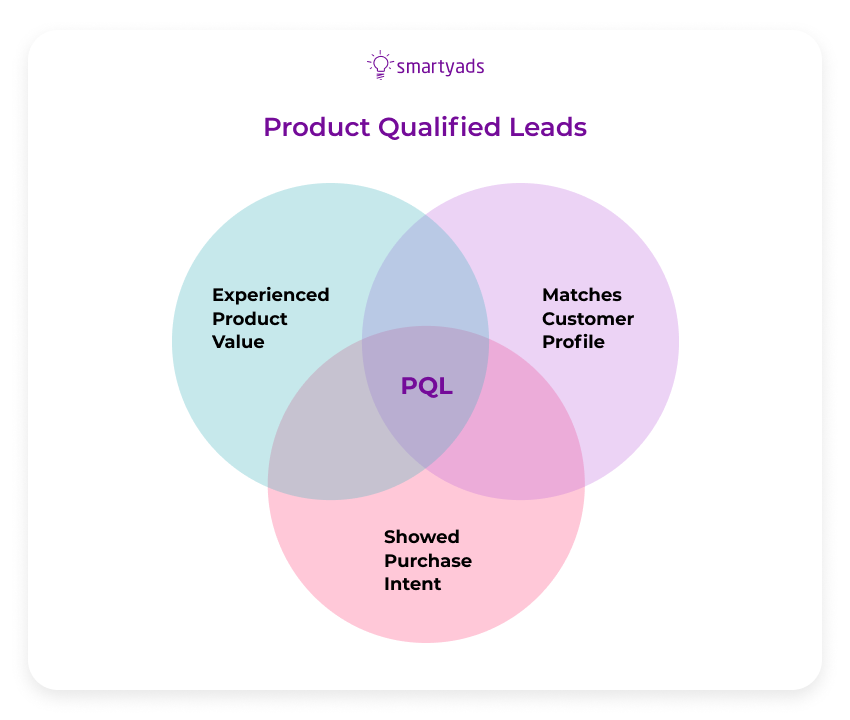
PQLs are usually qualified with analytics and user data showing high engagement and satisfaction levels with your product, such as frequent logins, active usage, and positive feedback.
PQLs are more likely to become paying customers because they have already experienced the value of your product.
Once identified, PQLs are usually passed on to the sales team for further tracking and conversion. The sales team can then use this product usage data to tailor their approach and messaging and focus on converting these leads into paying customers.
PQLs are especially useful for companies offering self-service or freemium products, as they can help determine which users are most likely to become paying customers and prioritize lead-generation efforts for those users who are most likely to generate revenue for the company.
Lead Generation: A Beginner's Guide to Generating Business Leads the Inbound Way
A lead generation campaign is the process of attracting and converting customers into leads, which are people who have shown interest in your products or services.
Inbound lead generation is a method of attracting customers to your business through content marketing, social media (Facebook lead generation ads, LinkedIn lead generation ads, Twitter lead generation ads), search engine optimization, and other tactics that focus on delivering value to your audience. Here's a beginner's guide to generating business leads in an inbound way.
Steps for Building Successful Lead Generation Campaign
The more leads the site generates, the larger the contact base the marketer can use to promote the company's products. To inspire trust and show the benefits and interest in products and services — the main task of generating leads.
Successful lead generation campaigns require careful planning, execution, and monitoring.
Use the right lead generation tools
Here are some steps to follow when building your lead generation campaign:
Define your target audience
Identify your ideal customer and create a buyer persona that includes their demographics, pain points, and goals.
Choose your lead magnet
Develop a valuable offer that addresses the needs and interests of your target audience, such as an e-book, whitepaper, webinar, or free trial.
Create a landing page
You can create a dedicated landing page that promotes your lead magnet and encourages website visitors to provide their contact information in exchange for the offer.
Drive traffic to your landing page
Use inbound and outbound marketing tactics to drive traffic to your landing page, such as social media, email marketing, content distribution, search engine optimization, paid advertising, and influencer marketing.
Optimize your lead capture form
Ensure that your lead capture form is easy to use and requires minimal effort from your website visitors. Use A/B testing to optimize the form for maximum conversions.
Nurture your leads
Use email marketing to nurture your leads, sending them personalized content that speaks to their interests and needs. Use segmentation and automation to create a more targeted and efficient lead-nurturing process.
Measure your results
Use analytics tools to track your website traffic, qualified leads, and conversions and adjust your strategy accordingly. Monitor your conversion rates, cost per lead, and return on investment (ROI) to ensure your campaign generates a positive ROI.
By following these steps, you can build a successful lead generation campaign that attracts potential customers, can capture lead information, and nurtures them into paying customers.
Remember to continuously optimize your campaign based on your results and adjust your tactics as needed to ensure you meet your goals.

Tips for Lead Gen Campaigns
Offer a free trial or a freemium version of your product
Offering a free trial or a freemium version of your product is a great way to attract customers and encourage them to try your product before they commit to a purchase. This way of attracting new customers is often used in lead generation strategies. Here's how to do it:
Product Trials
1) Choose the right product. Consider offering a free trial or a freemium version of your product that is easy to use and provides immediate value to your customers.
2) Define the terms of the trial. Determine the length of the trial period and the features that will be available during the trial. Be clear about what happens when the trial ends, such as the customer being prompted to upgrade to a paid version.
3) Promote the trial. Advertise your free trial or freemium version through your website, social media channels, email marketing, and other relevant platforms. Use messaging that highlights the value and benefits of your product.
4) Provide excellent support. Ensure that your customer support team is equipped to handle inquiries and issues that may arise during the trial period. Provide clear instructions on how to use the product and troubleshoot common problems.
5) Follow up with leads online. After the trial period ends, follow up with leads to gather feedback and encourage them to upgrade to a paid version. Use this opportunity to address any questions or concerns they may have.
By offering a free trial or freemium version of your product, you can provide customers with an opportunity to try your product before committing to a purchase and encourage them to become paying customers.
Why does a free trial or a freemium product work so well for a lead generation campaign?
Freemium is a good tool to generate leads. As long as a person doesn't understand the value of the product, they are not willing to pay for it. The trial period allows them to test the features and decide whether to subscribe.
For example, Spotify offers a free 60-day premium trial. However, the offer is only valid for 13 days.
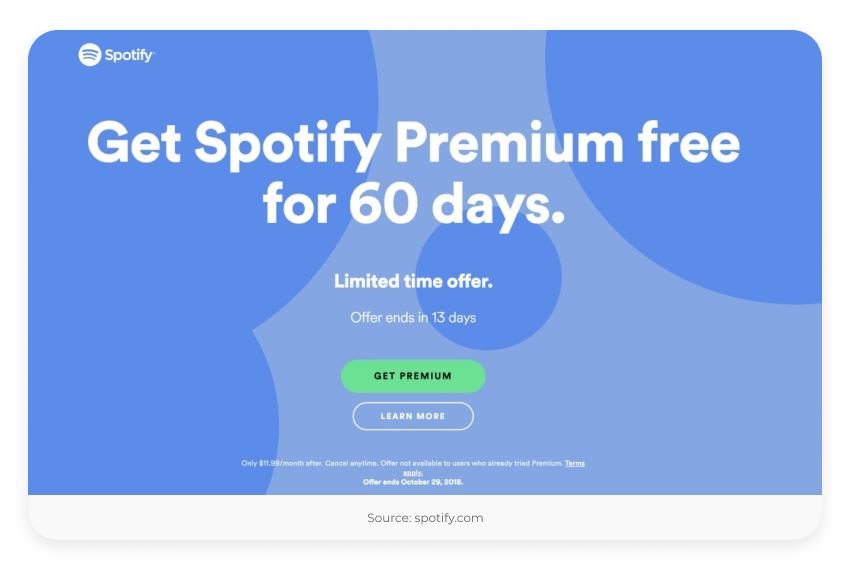
On average, the trial period lasts 7-30 days. This depends on the time the users take to understand the product's value. The cost of user engagement and lifetime value also affect this figure.
By offering a free trial or freemium product, you are lowering the barrier to entry for customers. They can try your product without making a financial commitment, which makes it easier for them to consider trying it out.
Offer free webinars
In order to encourage targeted registrations and recruit subscribers, you need to set up a delicate "lead magnet" — something of great value to the users, for which they will unconditionally agree to give up their email and interact with you.
Webinars with pre-registration are a great lead gen channel: even if the user does not come to the webinar, their email will still remain in your database and go into the possession of sellers, who will continue to interact with them.
Another argument favoring webinar marketing is that recording a webinar can further place its archive on the site. Access to viewing it is also open for email.
Optimize your lead capture mechanisms
Plan your content
Planning your content for an online lead generation campaign is important in creating an effective lead gen campaign. Generating leads is a top three goal for content marketers. Optimizing your content marketing strategy covers the following basic areas:
- Increasing audience reach;
- Reducing distractions;
- Increasing motivation.
Based on this theory, you can begin to optimize your content marketing strategy.
Content marketing helps drive leads
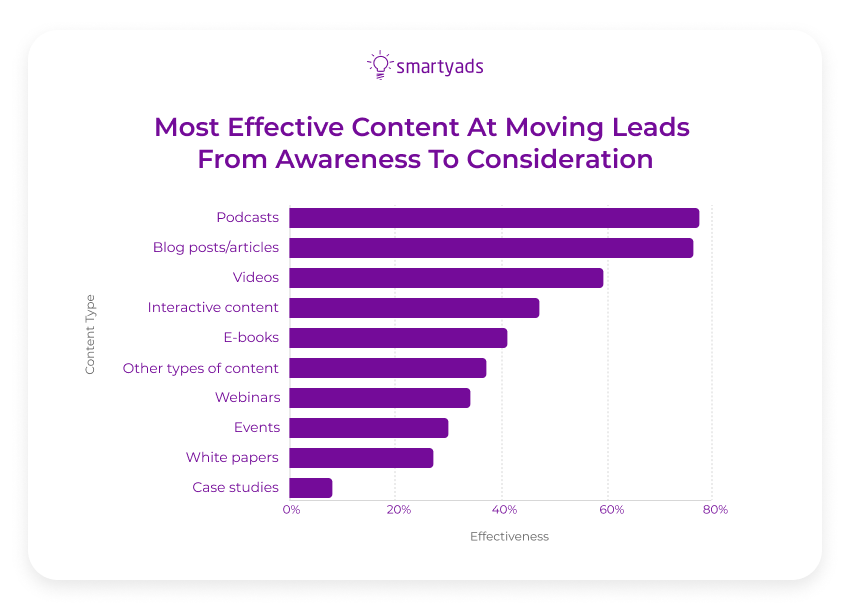
Create amazing offers for all different stages of the buying cycle

Creating an offer is an important part of lead generation campaigns because it provides a valuable incentive for customers to engage with your business and share their contact information.
By offering something of value in exchange for a lead's contact information, you can build a list of qualified leads interested in your product or service.
Creating an offer also helps your lead generation campaigns to:
Stand out from the competition. By offering something unique and valuable, you can differentiate your business from your competitors and attract more leads.
Showcase your expertise. An offer that provides valuable information or insights can position your business as a thought leader in your industry and help build trust with customers.
Build a relationship with leads. Offering something of value shows that you care about your customers' needs and are committed to providing solutions. This can help build a relationship with leads and encourage them to become loyal customers in the future.
Move leads further down the sales funnel. By offering something that addresses your target audience's pain points or needs, you can attract leads that are more likely to become customers.
Once you have their contact information, you can continue nurturing them through the sales funnel until they are ready to purchase.
Promote your content or offer
It's impossible to convert blog visitors into customers if the former simply doesn't exist. You may not get the leads you need if you don't attract visitors to your site or blog.
Another problem is that you are attracting traffic, but it is not targeted. If this is your case, you can advertise your product or service as much as you want, but you will get a minimal return.
Here are a few ways to attract and convert the right visitors, which are targeted for a successful lead generation campaign.
Guest blogging with a link to landing pages
Blog readers tend to be a clearly targeted audience, so guest posting on the right blogs can yield excellent results. However, for guest blogging to generate leads, include links to landing pages in your posts with an offer to download premium content (e-book, research, case study, or something similar).
Tips:
- Post links to premium content whose topic is the same as the topic of your guest post;
- Offer unique and useful premium content;
- Track the number of clicks on the link to understand the effectiveness of the post.
Use social media in your lead generation strategy
Marketers increasingly rely on social media to generate leads because there are 4.65 billion active social media users worldwide. Both B2B and B2C brands actively pursue social media.
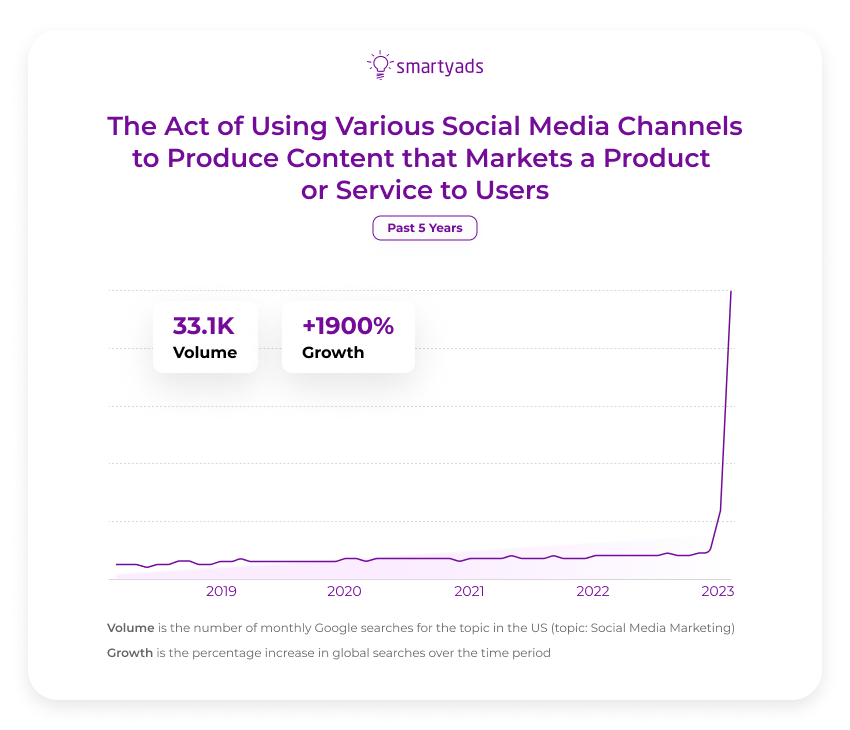
Participate and network by sharing your expert opinion in social media communities and groups on LinkedIn, Facebook, and Professionals. You can also use Facebook lead generation ads (Facebook lead ads) and other media lead generation ads.
These communities are the perfect platform to post the articles you want, attract traffic and gather potential clients' contact information.
Tips:
- Find communities like these and become a member. Contribute to these communities by posting notes and articles;
- Pay attention to other people's posts. Comment on them and link to your own resources where appropriate. This will help generate more leads.
Use a quiz as a lead magnet in your lead generation strategy
Using a quiz as your lead magnet is an effective way to generate leads for your business. Here are the steps to use a quiz as your lead magnet:
1) Choose a relevant topic. Choose a topic that is relevant to your business and target audience. The topic should address a common problem or pain point in your industry;
2) Determine the type of quiz. Determine the type of quiz that you want to create. This could be a personality quiz, a knowledge quiz, a survey, or any other type of quiz that is relevant to your topic;
3) Create engaging and relevant questions. Create engaging and relevant questions that provide valuable insights about your audience. Make sure the questions are easy to understand and provide clear choices for the quiz taker;
4) Provide personalized results. Provide personalized results that are relevant to the quiz taker. Make sure the results are based on the responses of the participant and provide actionable insights or recommendations;
5) Include a clear call-to-action. Include a clear call-to-action that encourages the quiz taker to provide their contact information. This could be a form where they enter their email address or phone number to receive their results;
6) Promote your quiz. Promote your quiz on social media and other relevant channels to attract more leads. You can also use paid advertising to reach a wider audience;
7) Follow up with your leads. Once you have collected your leads' contact information, follow up with them by sending personalized emails, offering special promotions or discounts, or providing additional resources relevant to their interests.
Remember to continuously test and optimize your quiz to improve its effectiveness and attract more leads.
Two examples of lead magnet powerhouses
Let's look at just a few examples of how lead magnets can work with real-case scenarios.
HubSpot's "Marketing Grader"
HubSpot's "Marketing Grader" is a free online tool that analyzes a business's marketing efforts and provides a score based on its performance.
This lead magnet has been incredibly successful in generating leads for HubSpot, as businesses are willing to provide their contact information in exchange for a free analysis. Once the lead has been captured, HubSpot follows up with personalized recommendations and offers for its marketing tools and services.
Canva
Canva is a popular design tool offering various templates, graphics, and other design resources. They offer a free version of their software, which allows users to create designs and graphics for free.
By offering a freemium product, Canva has attracted a large user base and generated a steady stream of leads for its premium subscription service.
So, what we have to say in conclusion
Lead generation campaigns are essential for businesses looking to attract leads, increase sales and build brand awareness.
By investing in lead generation, companies can create a steady stream of leads that can be developed and converted into paying customers, which can lead to long-term growth and success.
Don't delay launching your lead generation campaign, and create it with SmartyAds!

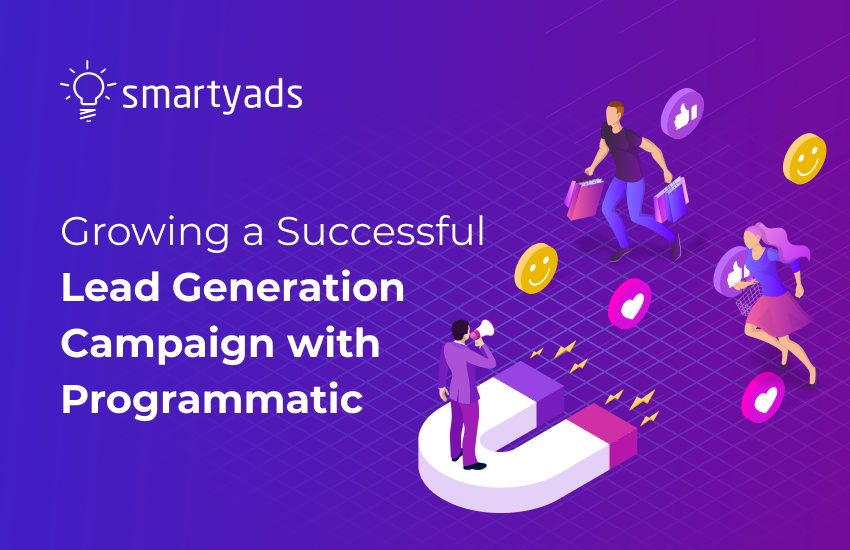
.webp)


